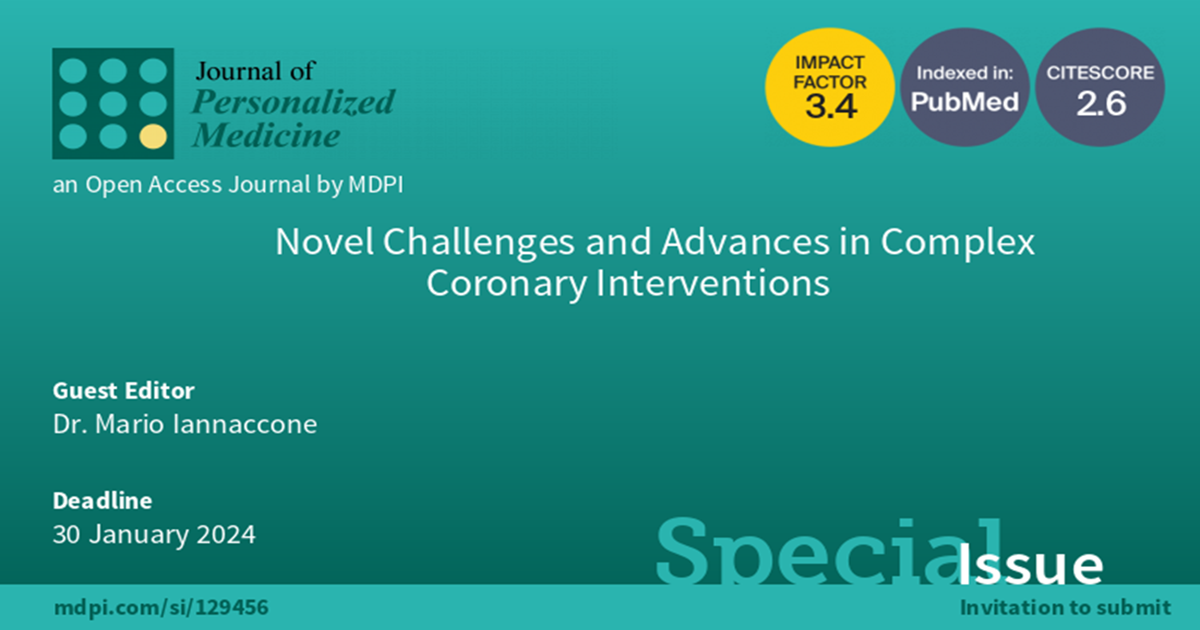Novel Challenges and Advances in Complex Coronary Interventions
A special issue of Journal of Personalized Medicine (ISSN 2075-4426). This special issue belongs to the section "Clinical Medicine, Cell, and Organism Physiology".
Deadline for manuscript submissions: closed (30 January 2024) | Viewed by 27398

Special Issue Editor
Interests: complex coronary interventions; chronic total occlusion recanalisation; intracoronary imaging; left ventricle mechanical support devices
Special Issues, Collections and Topics in MDPI journals
Special Issue Information
Dear Colleagues,
Thanks to the technical progress and the safety improvement in interventional procedures, percutaneous coronary intervention and cardiogenic shock are rapidly expanding toward more complex technical and clinical scenarios.
In this clinical setting, the effects of transient coronary occlusion due to the different procedural steps may cause temporary hemodynamic instability. Percutaneous mechanical circulatory support (pMCS) devices emerged as a potential tool to prevent procedure-related hemodynamic compromise by unloading the ventricle and augmenting forward flow, thus potentially reducing ischemia and decreasing myocardial injury ultimately resulting in worse mid and long-term outcomes.
The aim of this issue is to evaluate the role of pMCS in high-risk PCI and primary PCI, in particular Impella and ECMO.
Dr. Mario Iannaccone
Guest Editor
Manuscript Submission Information
Manuscripts should be submitted online at www.mdpi.com by registering and logging in to this website. Once you are registered, click here to go to the submission form. Manuscripts can be submitted until the deadline. All submissions that pass pre-check are peer-reviewed. Accepted papers will be published continuously in the journal (as soon as accepted) and will be listed together on the special issue website. Research articles, review articles as well as short communications are invited. For planned papers, a title and short abstract (about 100 words) can be sent to the Editorial Office for announcement on this website.
Submitted manuscripts should not have been published previously, nor be under consideration for publication elsewhere (except conference proceedings papers). All manuscripts are thoroughly refereed through a single-blind peer-review process. A guide for authors and other relevant information for submission of manuscripts is available on the Instructions for Authors page. Journal of Personalized Medicine is an international peer-reviewed open access monthly journal published by MDPI.
Please visit the Instructions for Authors page before submitting a manuscript. The Article Processing Charge (APC) for publication in this open access journal is 2600 CHF (Swiss Francs). Submitted papers should be well formatted and use good English. Authors may use MDPI's English editing service prior to publication or during author revisions.
Keywords
- complex coronary interventions
- pMCS
- PCI
- Impella
- ECMO
- chronic total occlusion recanalization
- intracoronary imaging
- left ventricle mechanical support devices
Benefits of Publishing in a Special Issue
- Ease of navigation: Grouping papers by topic helps scholars navigate broad scope journals more efficiently.
- Greater discoverability: Special Issues support the reach and impact of scientific research. Articles in Special Issues are more discoverable and cited more frequently.
- Expansion of research network: Special Issues facilitate connections among authors, fostering scientific collaborations.
- External promotion: Articles in Special Issues are often promoted through the journal's social media, increasing their visibility.
- e-Book format: Special Issues with more than 10 articles can be published as dedicated e-books, ensuring wide and rapid dissemination.
Further information on MDPI's Special Issue polices can be found here.






